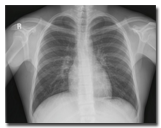Size estimation:
Common clinical surgical rule: pneumothorax greater than 25% requires chest tube drainage
Drainage actually depends on physiologic status of patient
Small pneumothorax may be devastating in COPD patient with little reserve and conversely a tension pneumothorax may be well tolerated in young athlete
Air slowly resorbs from the pleural space at a rate of approximately 1.5% / day. This rate will increase with use of supplemental oxygen. (Nitrogen is the largest component of the atmosphere and is not metabolized. Thus the partial pressure gradient between the air in the pleural space and capillary blood is small. If nitrogen is decreased by increasing the inspired oxygen concentration, the rate of resorption will increase.)
| References |
| Choi BG, Park SH, Yun EH, Chae KO, Shinn KS. Pneumothorax size: correlation of supine anteroposterior with erect posteroanterior chest radiographs. Radiology 1998; 209:567-569. [Related Records]
Collins CD, Lopez A, Mathie A, et al. Quantification of pneumothorax size on chest radiographs using interpleural distances: regression analysis based on volume measurements from helical CT. AJR Am J Roentgenol 1995; 165:1127-1130. [Related Records] Engdahl O, Toft T, Boe J. Chest radiograph--a poor method for determining the size of a pneumothorax. Chest 1993; 103:26-29. [Related Records] Rhea JT, DeLuca SA, Greene RE. Determining the size of pneumothorax in the upright patient. Radiology 1982; 144:733-736. [Related Records] Axel L. A simple way to estimate the size of a pneumothorax. Invest Radiol 1981; 16:165-166. [Related Records] |







